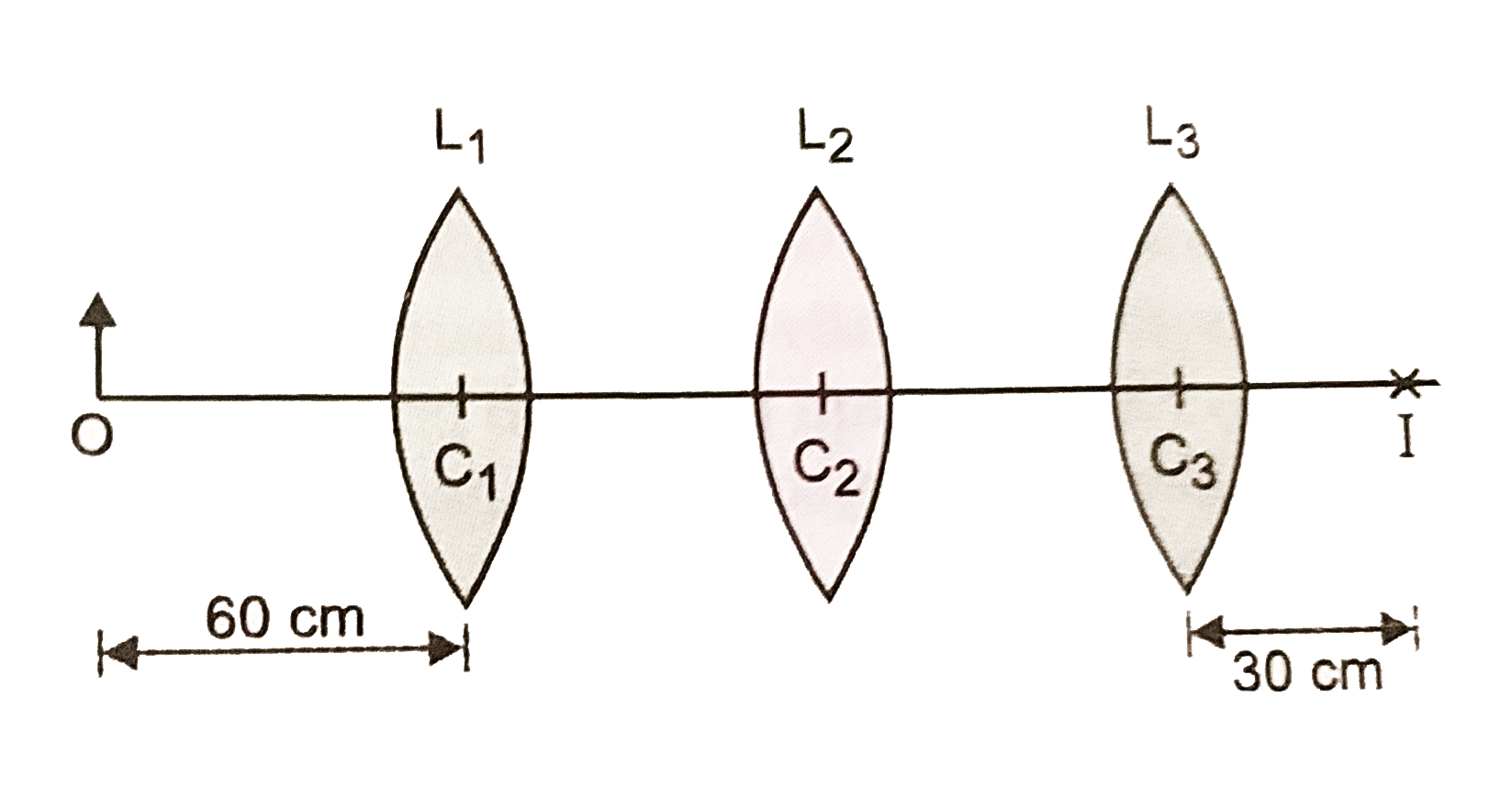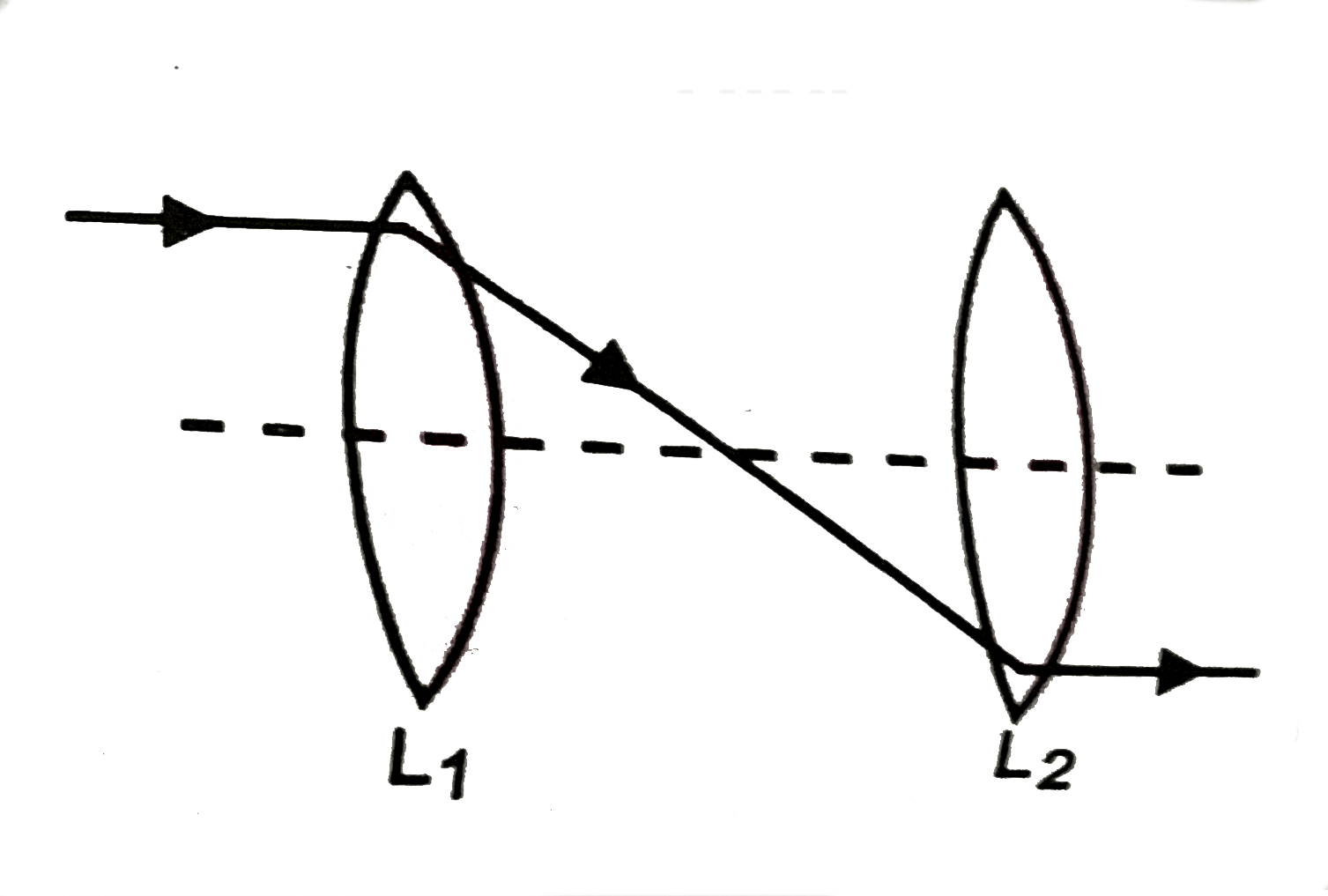Three lenses L1,L2,L3 each of focal length 30cm are placed co-axially as shown in (Fig. 11(b).57).
An object is held at 60cm from the optic centre of lens L1. The final real image is formed at the focus of L3. Calculate separation between
(i) L1 and L3
(ii) L2 and L3 ?
 .
.
For lens l1,u=−60cm,f=+30cm.
If v1 is distance of image I1 from C1, then from
1v1−1u=1f1
1v1=1f1+1u=130−160=160
v1=60cm=C1I1
As final image I is at focus of L3, therefore, rays falling on L3 must be parallel tom commen principal axis. For this to happen, I1 must be at the focus of L2. Hence distance between L1L2 is
=C1C2=C1I1+I1C2=60cm+30cm=90cm
and distance between L2andL3 can have any reasonable value, as rays between L2 and l3 are parallel rays. The course of rays in shown in Fig.
 .
.
Topper's Solved these Questions
- RAY OPTICSBOOK - PRADEEPCHAPTER - RAY OPTICSEXERCISE - Solved Example(c )
21 Videos
- RAY OPTICSBOOK - PRADEEPCHAPTER - RAY OPTICSEXERCISE - Solved Example(d)
32 Videos
- RAY OPTICSBOOK - PRADEEPCHAPTER - RAY OPTICSEXERCISE - Sample problem(d)
5 Videos
- PROPERTIES OF BULK MATTERBOOK - PRADEEPCHAPTER - PROPERTIES OF BULK MATTEREXERCISE - Multiple choice questions
7 Videos
- SYSTEMS OF PARTICLES AND ROTATIONAL MOTIONBOOK - PRADEEPCHAPTER - SYSTEMS OF PARTICLES AND ROTATIONAL MOTIONEXERCISE - Assertion- Reason Type questions
20 Videos
Similar Questions
(a) Explain with reason, how the power of a diverging lens changes when (i) it is kept in a medium of refractive index greater than that of the lens, (ii) incident red light is replaced by violet light.
(b) Three lenses L1,L2,L3 each of focal length 30 cm are placed co-axially as shown in the figure. An object is held at 60 cm from the optic center of lens L1. The final real image is formal at the focus of L3. Calculate the separation between (i) (L1andL2)and (ii) (L2andL3).
View SolutionYou are given three lenses L1,L2andL3 each of focal length 20 cm. An object is kept at 40 cm in front of L1, as shown. The final real image is formed at the focus 'I' of L3. Find the separations between L1,L2andL3.

View Solution
Knowledge Check
Three lenses L1,L2,L3 are placed co-axially as shown in figure. Focal length's of lenses are given 30 cm , 10 cm and 5 cm respectively. If a parallel beam of light falling on lens L1, emerging L3 as a convergent beam such that it converges at the focus of L3 . Distance between L1 and L2 will be
 A40 cmB30 cmC20 cmD10 cm
A40 cmB30 cmC20 cmD10 cmThree straight lines L1,L2 and L3 are parallel and lie in the same plane. A total of m points are taken on L1, n points on. L2, K points on L3. The maximum number of triangles formed with vertices at these points are
A^(m+n+k)C3B^(m+n+k)C3−mC3−nC3C^(m+n+k)C3+mC3+nC3DNone of theseIn a laboratory four convex lenses L1,L2,L3 and L4 of focal lengths 2, 4, 6 and 8 cm, respectively are available. Two of these lenses form a telescope of length 10 cm and magnifying power 4. The objective and eye lenses are respectively
AL2,L3BL1,L4CL1,L2DL4,L1
You are given three lenses L1,L2andL3 each of focal length 10 cm. An object is kept at 15 cm in front of L1, as shown. The final real image is formed at the focus 'T' of L3. Find the separations between L1,L2andL3.

View SolutionL1-L3
View SolutionIn a laboratory four convex lenses L1,L2,L3 and L4 of focal lengths 2, 4, 6 and 8 cm, respectively are available. Two of these lenses form a telescope of length 10 cm and magnifying power 4. The objective and eye lenses are respectively
View SolutionIn Fig., there are two convex lenses L1andL2 having focal lengths F1 and F2 respectively. The distance between L1 and L2 will be :
 .
.
View SolutionIn a laboratory four convex lenses L1,L2,L3 and L4 of focal lengths 2,4,6 and 8cm respectively are available. Two of these lenses form a telescope of length 10cm and magnifying power 4 . The objective and eye lenses are
View Solution
